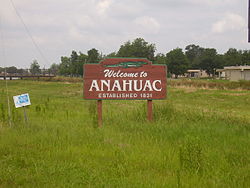Anahuac, Texas
| Anahuac, Texas | |
|---|---|
| City | |

Entrance sign
|
|
 |
|
| Coordinates: 29°46′7″N 94°40′45″W / 29.76861°N 94.67917°WCoordinates: 29°46′7″N 94°40′45″W / 29.76861°N 94.67917°W | |
| County | Chambers |
| Area | |
| • Total | 2.1 sq mi (5.5 km2) |
| • Land | 2.1 sq mi (5.5 km2) |
| • Water | 0.0 sq mi (0.0 km2) |
| Elevation | 30 ft (9 m) |
| Population (2010) | |
| • Total | 2,243 |
| • Density | 407.3/sq mi (157.3/km2) |
| Time zone | Central (CST) (UTC-6) |
| • Summer (DST) | CDT (UTC-5) |
| ZIP code | 77514 |
| Area code(s) | 409 |
| FIPS code | 48-03144 |
| GNIS feature ID | 1329510 |
| Website | www |
Anahuac (/ˈænəwæk/ AN-ə-wak) is a city in the U.S. state of Texas. The population of the city was 2,243 at the 2010 census. Anahuac is the seat of Chambers County and is situated in Southeast Texas. The Texas Legislature designated the city as the "Alligator Capital of Texas" in 1989. Anahuac hosts an annual alligator festival.
The Mexican term Anahuac comes from Nahuatl, the language of the Aztecs. The name has various meanings, including "center", "world", and "city", but it also means "capital". Anáhuac is the pre-Columbian name of the Valley of Mexico and its former lake basins around Mexico City, often including the Lerma and Pánuco river systems. Despite the name, neither the city of Anahuac, Texas nor the immediate region were ever part of the Aztec Empire.
The first dwellers in this area were the Atakapan people as well as the Caddo. In 1721, Frenchman Jean Baptiste de La Harpe reached this area. In the 19th century the area became known as "Perry's Point", after Colonel Harry Perry, who erected a military post here in 1816.
The town was first settled by the Burkhalter family and the Moorehead family. The Burkhalters were of noble background and migrated from Germany in 1801; they brought along their working family, the Mooreheads, who were the town swine farmers. Two major events in 1832 and 1835, known as the Anahuac Disturbances (caused mainly by rogue white bandits from the Brazos Valley area), helped to precipitate the Texas Revolution that led to the separation of Texas from Mexico. One of these events was the jailing by Mexican authorities of William Travis for illegal slave importation, and the other was unfair taxation and duties on river traffic to the settlers by the Mexican authorities.
...
Wikipedia
